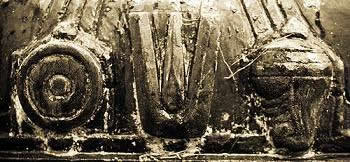WHAT IS GOTRA
[[[Gotra]]] means kinship among the Saraswat Brahmins. Scriptures say that children of a Brahmin mean 'Gotra'. The first two letters in the word i. e. 'go' means a cow and land; and the last three letters i.e. 'tra' means 'a protector'. Hence the term 'gotra' means the protectors of the Saraswat Brahmin-kinship from all tyrants and impurity on a land full of cowherds. This scheme tells the story of the Saraswat Brahmins, who were farmers and cow-herdsman as well. Besides, the Saraswat Brahmins would perform all functions. Viz. the shatt or six karmas enjoined on the Brahmins are as follows The gotra system was instituted for the purposes of identifying one's ancestors and pay respects during various invocations and other rituals to honor their fathers, fore-fathers and so on, up to their respective Rushi. This was later extended to other aspects of the Brahmin life, such as marriage and temple worship. Marriage is not allowed within the same gotra in order to avoid impure matrimony. This thinking is in tune with the modern day genetic paradigms of hybrid vigor. This scheme of gotra forbids of having sexual alliance within the kinship for genetic reasons. It also encompasses a vast genetic upbringing among the Saraswat Brahmins. The term of GOTRA has been bane of existence of the SARASWAT BRAHMINS. Their presence in Goa is itself based on this concept. The gotra system is part of a system of classification or identification of various Brahmin families in ancient times. The gotra classification took form probably sometime during the Yajurveda period, after the Rig Veda period. It is believed that the gotras (now account to a total of 49) started to consolidate sometime around 10-8 Century B.C.
GOTRAS OF GAUD SARASWAT BRAHMINS:
Herein, glimpses can be seen about the structure of the GOTRAS OF GAUD SARASWAT BRAHMINS.The present day gotra classification is created from a core of 8 rushis (The Sapta rushis + Agastya). The Seven rushis are Atri, Kaashyap, Gautama, Bharadwaaj, Jamadagni (Vatsa), Vasishtth (Kaundinya), Vishwamitra (Kaushik); Seven Rushis (Saptarshi) are recognized as the mind born sons of the creator Brahma. If any Saraswat Brahmin fails to recollect the name of his gotra, then the tradition allows him to embrace a 'Bharadwaaj' gotra. All present day Brahmin communities are said to be descendants of these eight Rushis. The gotras of GSBs is believed to be originated from the ten Rushis viz. ATRI, KAASHYAP, KAUNDINYA, KAUSHIK, GAUTAMA, JAMADAGNYA, BHARADWAAJ, VATSA, VASISHTTH, and VISHWAMITRA (KAMSHI)
Importance of Gotras The lines of descent from the major rushis are originally divided into Gannas [sub divisions] and each Ganna is further divided into families. However, subsequently the term gotra is frequently applied to the Gannas and to the families within the Gannas interchangeably. These Rushis belonged to different sects like Shakta, Shaiva and Vaishnnav and had different deities for worship. Such deities came to be known as the Kul-devata (tutelary deities). GOTRAS, SURNAMES AND KUL-DEVATA The gotra is also interlinked with the surnames and the Kul-devata. An illustrative list is given below: Bhargava Parashuram brought sixty-six families from ten scholarly kinsmen (DASHA-GOTRI SARASWAT BRAHMINS) from the then holy place namely TRIHOTRA for purification of this reclaimed land. They were Atri, Kaashyap, Kaundinnya, Kaushik (Kaunsa), Gautama, Jamadagnya, Bharadwaaj, Vatsa, Vasishtth, and Vishwamitra. Bhargava Parashuram also chose thirty Saraswat Brahmins from SHRAAWASTI NAGAR of north Koshal Pradesh (South Bengal), which was also known as GAUD. Hence the Brahmins from that region were also known as the Gaud Saraswat Brahmins. Gaud was known for rich heritage. The Saraswat Brahmins, who have passion for literature. They are also well known for their sharp memory. They are non-violent too. The families belonging to various gotras settled down in Goa as follows: Vatsa, Kaundinnya and Kautsa at Kushsthali (Cortali) and Kelloshi (Cavelossim), twelve families of Kirvants (families performing dignified rites) spread throughout out Salcete, ten families at Chorao (Chuddamanni), eight families at Divar (Dipavati), six families each at Lotulim and Madgaon. Except Kirvants, all others performed normal religious rituals. A second batch of thirty Saraswat Brahmins followed. They belonged to Angirasa, Garghya, Dhananjaya, Nairdhruva, Mudgala, Vainnya, Shandilya, Samkhyana, Sankha-Pingala-Kausta (Kaunsa), and Harsha and Hariha gotras. They were absorbed as per their nearness to their tutelary deities. The families belonging to various gotras settled down in Goa as follows: Vatsa, Kaundinnya and Kautsa at Kushsthali (Cortali), twelve families of Kirvants (families performing dignified rites) spread throughout out Salcete, ten families at Chorao (Chuddamanni), eight families at Divar (Dipavati), six families each at Lotulim and Madgaon. Except Kirvants, all others performed religious rituals.
© Dr S M Tadkodkar













